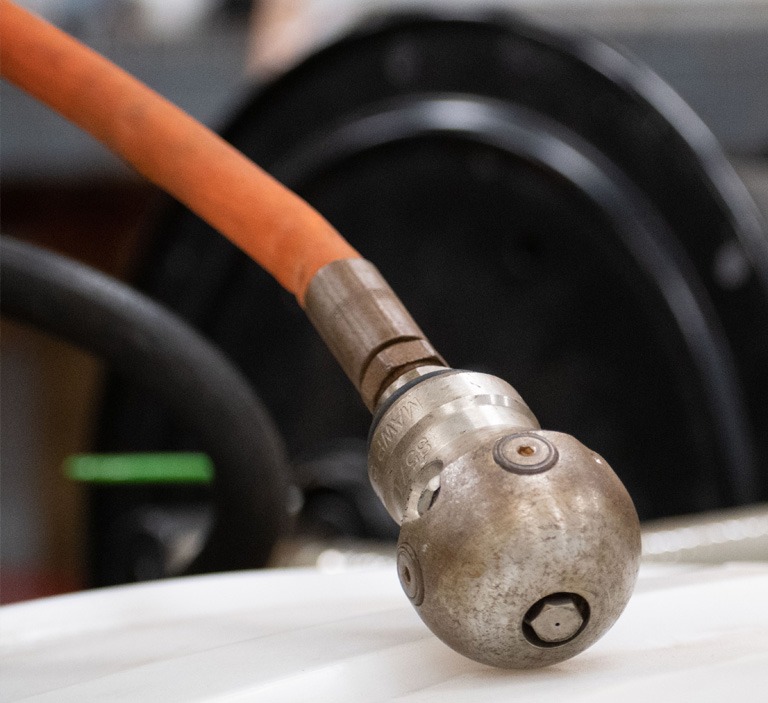Clogged drains and sewer lines can be a major headache for homeowners and businesses alike.
You’ve tried drain cleaner but you’re still experiencing slow drains or, even worse, these clogs have led to a complete sewer back-up. While there are various ways to address this problem, there are situations where hydro jetting is the best solution for drain cleaning.
Continue reading to learn what hydro jetting is, how the process works, when to use it, and the benefits it provides over other drain cleaning methods.
How Hydro Jetting Works
The hydro jetting process uses a high-pressure stream of water to clear clogged pipes and sewer lines. A hydro jetting machine’s components include a tank of water and a high-powered pump that creates water pressure of up to 4,000 PSI.
A hose with a special nozzle directing the water stream is connected to the pump. The nozzle has multiple jets that shoot out water in various directions. This is how it’s able to clean the internal walls of pipes so thoroughly.
A sewer snake, or auger, uses a long, flexible metal rod with sharp blades at the end that is rotated within the pipe, powering the blades to cut through the clogs. Sometimes this works but often the elements of the clog – extreme grease build-up, dirt, or other stubborn materials – remain in the pipes, which means the pipe can quickly clog again.
What sets this method apart from other drain cleaning methods – like drain clearing liquids, the DIY combination of hot water and baking soda, and snaking – is its effectiveness at removing existing blockages and preventing future clogs.
When to Use Hydro Jetting
Hydro jetting is recommended if you are noticing:
- Drains that are slow to empty
- Gurgling noises coming from your pipes
- Frequent back-ups
- Foul odors coming from your plumbing system
This is especially true If you have an older plumbing system that is more susceptible to clogs and blockages.
What kinds of clogs can hydro jetting handle?
- Hair clogs
- Mineral build-up
- Grease and fat residue
- Food deposits
- Silt and sand build-up
- Soap build-up
- Tree roots (most prevalent in main sewer line)
You may choose to schedule a hydro jetting service once or twice a year as preventative maintenance to avoid the conditions that lead to a clog.
The Hydro Jetting Process
The hydro jetting process starts with a visit from a professional plumber. The plumber will work to locate the blockages starting with a video inspection. Using a video camera placed inside your pipes, once the plumber has confirmed that your pipes can withstand the hydro jetting process, they will determine the best place to insert the hose and begin pumping the water.
The plumber will monitor and adjust the water pressure levels throughout the course of the hydro jetting procedure, based on the condition of your pipes and the power required to remove the clog. The water will work to both remove the obstruction and clean the insides of the pipes as it courses through the plumbing system.
Safety and Precautions
Hydro jetting gets the job done but in order for it to be a complete success, you must take precautions to prevent damage to your pipes, appliances, and plumbing system.
That’s why it’s so important to consult with a professional plumber. They have the equipment and the proper training to safely apply the process. That includes the camera inspection to inspect your pipes beforehand. The last thing you want is to cause significant damage to your plumbing system by attempting hydro jetting on your own.
Benefits of Hydro Jetting
The main benefit of hydro jetting is its effectiveness. It reaches otherwise inaccessible places within your plumbing system, removing difficult clogs and blockages.
Hydro jetting is also an environmentally friendly option. By using only water to clean out the pipes, it avoids the use of harsh chemicals.
Because hydro jetting works to prevent future clogs from forming, it reduces the need for frequent plumbing services. It also helps avoid larger issues like burst pipes and major leaks, saving you time, frustration and money.
How Much Does Hydro Jetting Cost?
The cost of hydro jetting varies, depending on the following factors:
- Size of the plumbing system
- Severity of the clog – the more severe, the more time it will take to clear the blockage
- Access to the clog – if the clog is close to the sewer line access point, the procedure will be less expensive
Overall, hydro jetting is still among the most cost-effective options to resolve clogs and blockages, especially since it provides a long-lasting, pre-emptive solution.
Maintain Your Drains to Prevent Clogs
It’s great that hydro jetting exists but it’s also a good idea to pursue regular maintenance of your plumbing system to prevent clogs and blockages. We recommend having your pipes cleaned using hydro jetting at least once a year to keep them in good condition.
You can also keep your pipes clear by avoiding pouring grease, oil, and other materials down your drains that can contribute to clogs. It also helps to use a drain strainer to prevent materials like hair and food particles from entering your pipes.
Don’t Go It Alone
Hydro jetting is an effective and efficient way to clear a clogged drain or sewer lines. But all of those benefits are lost if it’s performed by a well-meaning individual giving it a try in an attempt to save money. The damage that can occur if the process is done incorrectly is far more expensive than the cost of a visit from a plumbing professional.
If your plumbing system is showing signs of a possible problem, give us a call at 215.799.2019 or fill out the form below. We’ll be happy to take a look and offer solutions.


